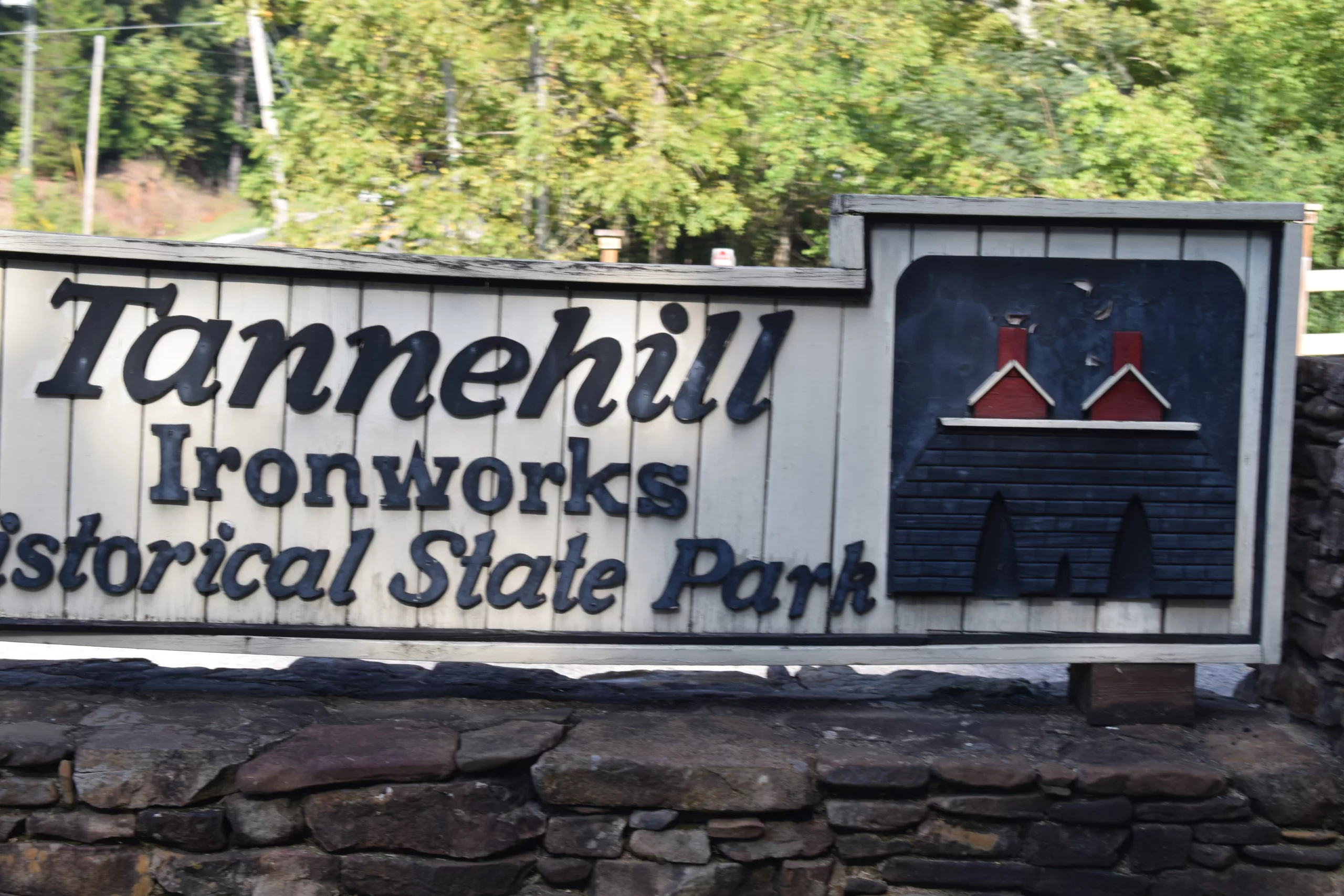We hadn’t planned this stop. With Sloss Furnaces closed and a little time to kill after visiting The Old Grist Mill, Dusty and I pointed the truck toward Tannehill Historic State Park, not really knowing what we’d find. Honestly, I thought it might just be a quiet patch of Alabama nature—a picnic spot, maybe a trail or two.

But state parks have a way of surprising us. Instead, we stumbled into an entire preserved world: log cabins, a museum, a church, a cemetery—and, though we didn’t know it at the time, three towering stone furnaces that once forged the Confederacy’s weapons of war.
Tannehill isn’t just another park—it’s a hidden chapter of Civil War history, layered with both innovation and dark secrets.
A Valley of Fire
At first glance, those furnaces look like mossy monuments—stone giants frozen in place. But in their day, this valley roared with fire.
To understand Tannehill, you have to understand the world it was built in. The Civil War wasn’t just fought with rifles and cannons—it was fought with factories, foundries, and iron. The South had little industrial infrastructure, but what it did have, it leaned on hard.
Here, in Alabama’s secluded Roupes Valley, the conditions were perfect: iron ore in the hills, endless forests for charcoal, and water to power the works.
Between 1859 and 1863, ironmaster Moses Stroup built three massive blast furnaces. They were cutting-edge for their time—steam engines and hot blast stoves helping them produce up to 22 tons of pig iron a day, much of it shipped to the Selma Naval Gun Works and Arsenal, where it became cannons and rifles for the Confederate Army.
For a few short years, this quiet valley became one of the beating hearts of the Southern war machine.
The Hands That Built It
But here’s the harder truth. This machine didn’t run on iron alone—it ran on people. Hundreds of them.
Miners dug ore from the hills. Colliers tended smoky charcoal pits. Furnace men worked through nights lit by molten fire.
And many of them were enslaved men. They cut the sandstone blocks, hauled them into place, and built the very furnaces that still stand here. They labored in heat, danger, and darkness with no choice in the matter.
When Dusty and I stepped up to the little church on site, she paused and whispered, “Can you imagine the lives lived here?” And she was right. The real story isn’t just in the stone stacks—it’s in the hands that fed them.
That’s the sobering part of walking through Tannehill: you can’t separate the industry from the human cost.

The Day the Fires Went Out
By 1865, the Confederacy was collapsing. Union General James H. Wilson launched the largest cavalry raid of the war, aimed at destroying the South’s remaining industrial backbone.
A detachment of about 1,500 men rode into Roupes Valley on March 31st, 1865. By then, the furnaces had gone quiet—the workers likely fled into the hills. The soldiers weren’t there to fight; they were there to erase Tannehill.
They smashed the furnaces, destroyed the steam engine, and set fire to the bridges, casting houses, and warehouses. In just hours, the valley’s roar of iron and flame was reduced to silence.
Standing here today, with birdsong in the trees, it’s hard to imagine that same valley choking on smoke and ash. But history says it happened—and the silence that followed has lasted for more than 150 years.
Echo’s Corner: Legends in the Ashes
(Because every old furnace has a few ghost stories…)
The most famous tale from Tannehill is the legend of Isam Hardee, an enslaved worker who, according to folklore, leapt into a blazing furnace after being accused of theft. It’s a horrifying image—but here’s the thing: there’s no historical record that it ever happened. The story likely emerged years later, as a way to explain the lingering heaviness of this place.
Other whispers tell of a man named Jeb, said to have been killed by Union soldiers, and of a little girl singing “Ring Around the Rosie” near one of the relocated cabins.
But maybe the most haunting thing about Tannehill isn’t the ghost stories at all—it’s the weight of what really happened here.

Exploring the Park
For us, the visit wasn’t just about history—it was about discovery.
When we first parked, we stopped at the historic signs to get our bearings, then wandered the old log cabins along the main road. Dusty and I even talked about maybe renting one of those cabins one weekend, just to slow down and soak in the past.
The museum was our biggest surprise. We hadn’t realized Tannehill was tied so deeply to Civil War history until we stepped inside. We split up to explore—I was drawn to the military displays, Dusty to the iron and industry exhibits.
As a military veteran, and with Dusty’s background as a Navy brat, we each felt the weight of it in different ways.
Honestly, the only disappointment? There wasn’t a gift shop. I had my heart set on a magnet, and Dusty wanted lapel pins for our Alabama travel dolls (yes, ours are dressed in peanut costumes and covered in pins from every stop).
Behind the museum, we explored the remnants of the ironworks—stone foundations, bits of machinery—but not the towering furnaces themselves. Somehow, we completely missed them.
Apparently Dusty had learned they were here but forgot to clue me in. Later that day, at Brierfield Ironworks, she finally shouted, “We found a furnace! We’ve been looking for them all day!”
So yes, we did end the day with a furnace—just not the Tannehill ones. Guess that’s one more reason to come back.

Today’s Tannehill
These days, Tannehill is at peace. Its 1,500 acres hold walking trails, a working gristmill, a blacksmith shop, and more than forty cabins relocated from across Alabama.
It’s not just a memorial—it’s a living museum. The furnaces here are considered some of the best-preserved in the South, standing as a testament to both the industry and the lives that built them.
We didn’t catch them this time, but that just means we’ve got the perfect excuse to come back.
Final Thoughts
Tannehill Historic State Park is a place of contradictions: innovation and forced labor, war and silence, documented history and whispered legend.
We came here by accident, but we left with one of our favorite stops of the entire trip. And that’s the beauty of road travel—sometimes, the detours are the destinations.
💌 Thanks for Wandering with Us
Every week, we uncover another forgotten story from the South—one ghost town, roadside legend, or sacred ruin at a time. Want to come along?
→ Join the Travel Made Personal mailing list
For behind-the-scenes updates, freebies, and new posts straight from the road.

If you see this after your page is loaded completely, leafletJS files are missing.
Related Adventures
- Bellamy Bridge Historic Site — where history and legend meet in the moonlight.
- Sadler Plantation Home — echoes of 19th-century Alabama.
- Brierfield Ironworks State Park — the furnace we finally found!

